NCERT Solutions for Class 10 Science Chapter 1 – Chemical Reactions and Equations
NCERT Solutions for Class 10 Science Chapter 1 – Chemical Reactions and Equations are essential for understanding key Chemistry concepts in the CBSE curriculum. These well-structured answers help students grasp topics like types of chemical reactions, balancing equations, and effects of oxidation. Designed as per the latest syllabus, these solutions strengthen conceptual clarity and improve exam preparation. Ideal for revision and practice, they encourage logical thinking and scientific understanding, making them a valuable study tool for scoring well in Class 10 Science exams.
NCERT Solutions For Class 10 Science – Chemical Reactions and Equations – Exercise Images
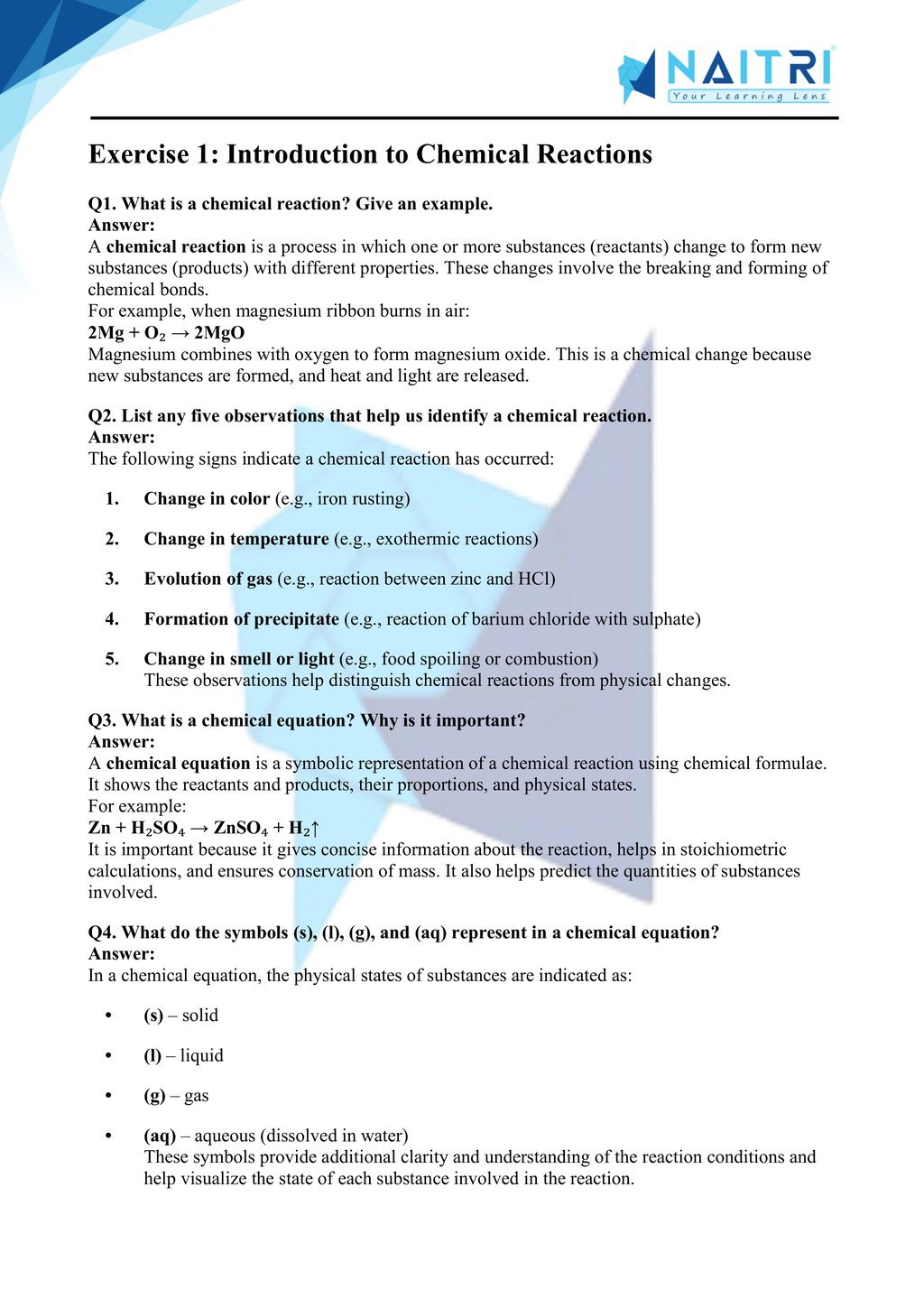
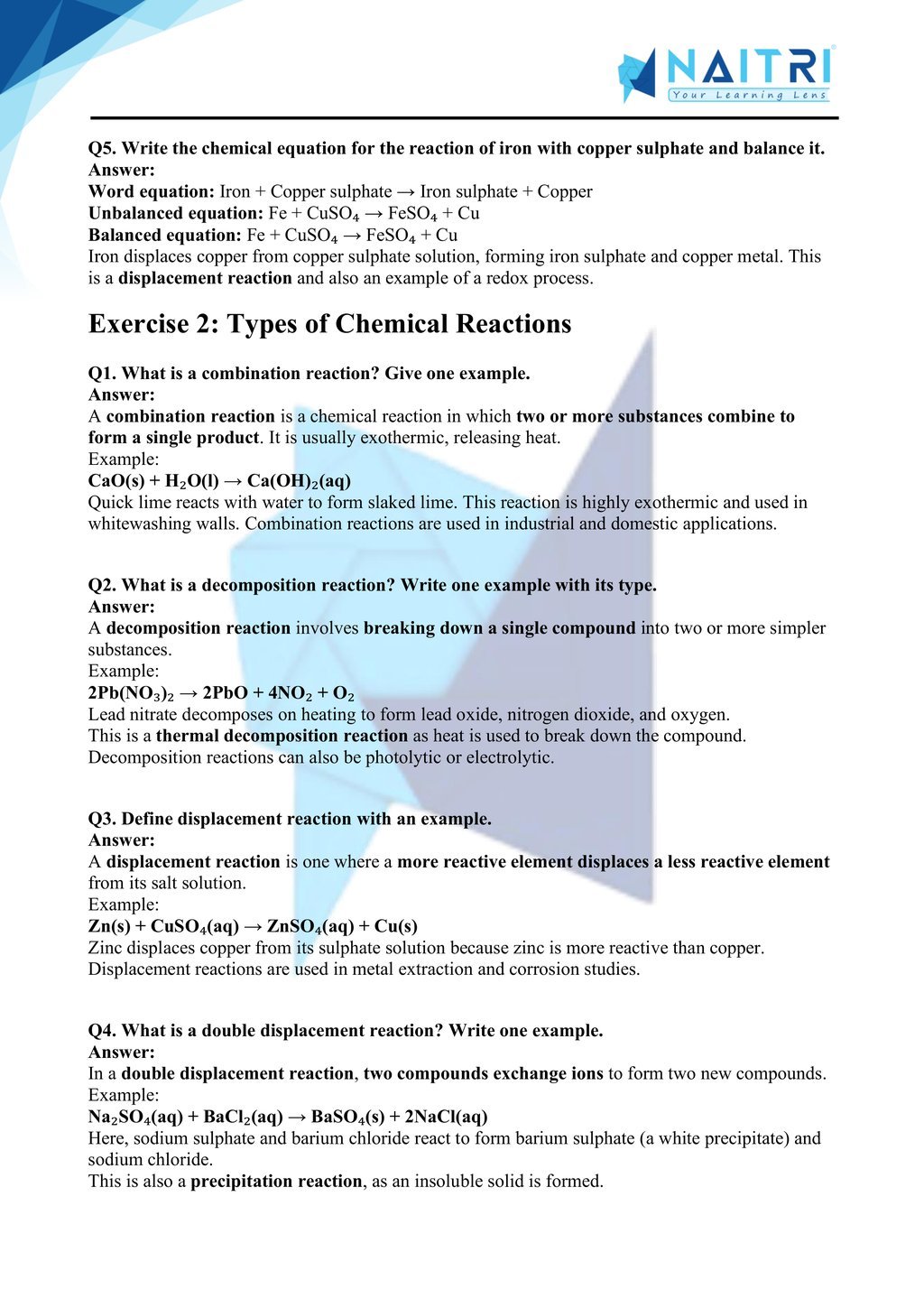
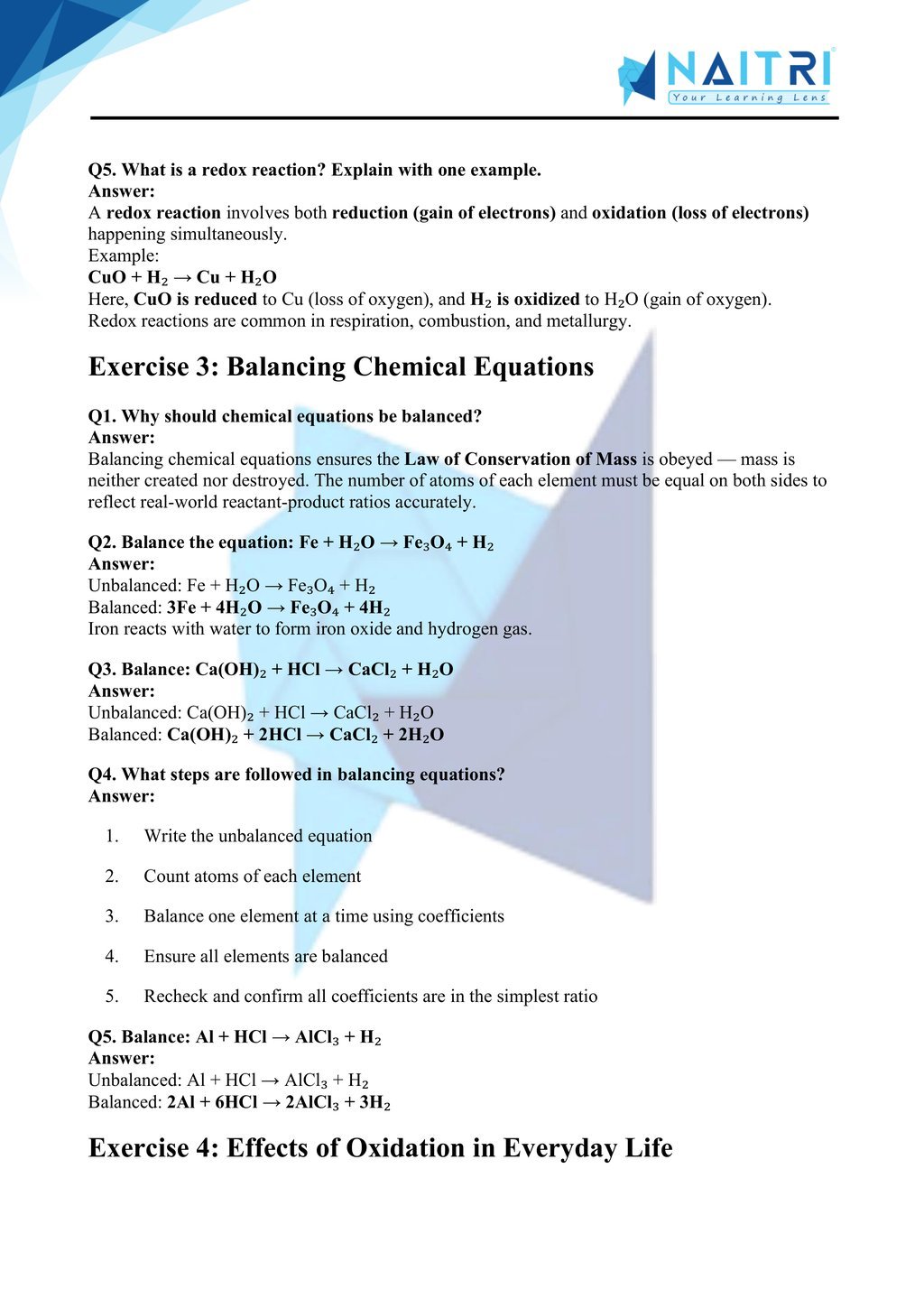
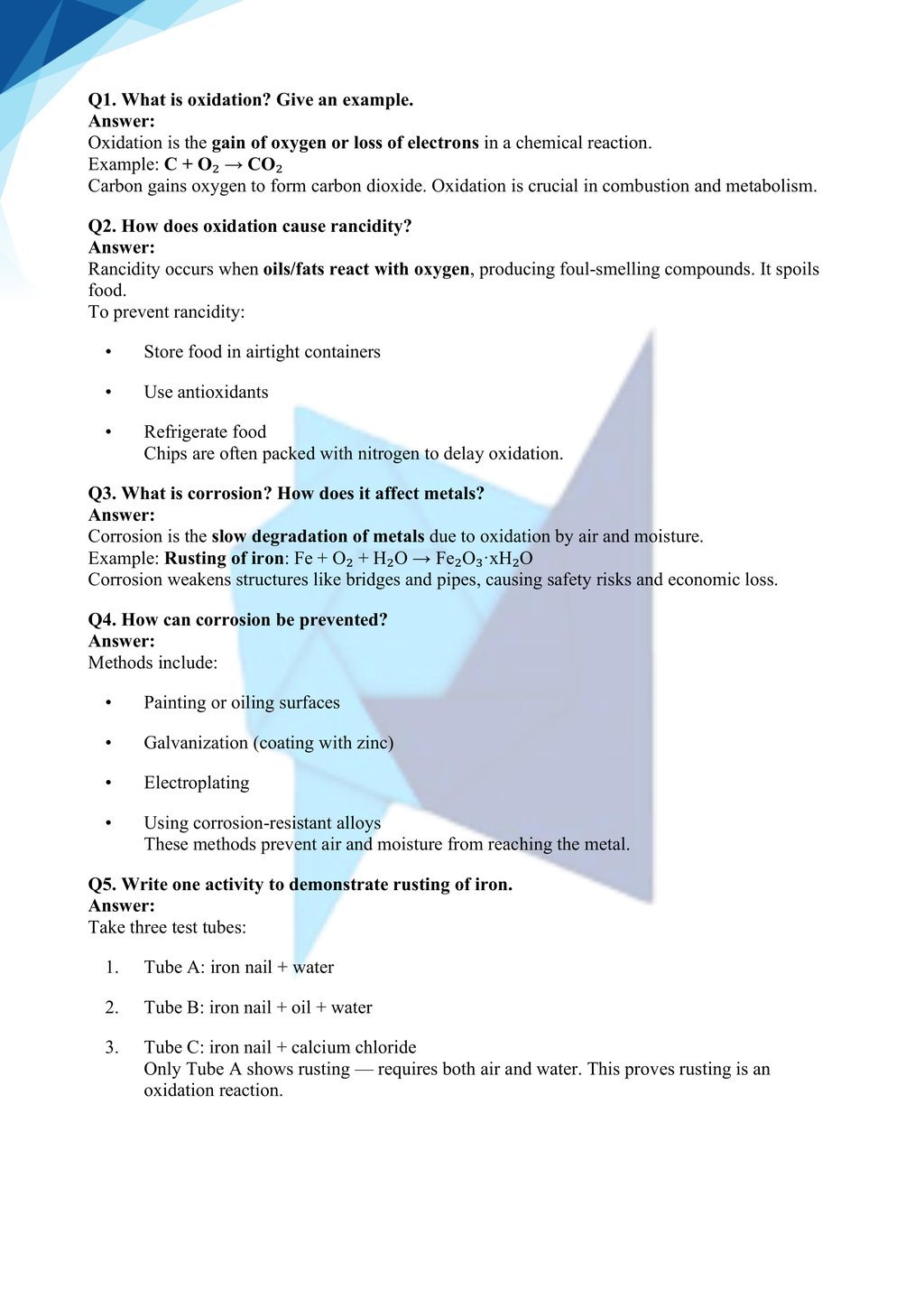
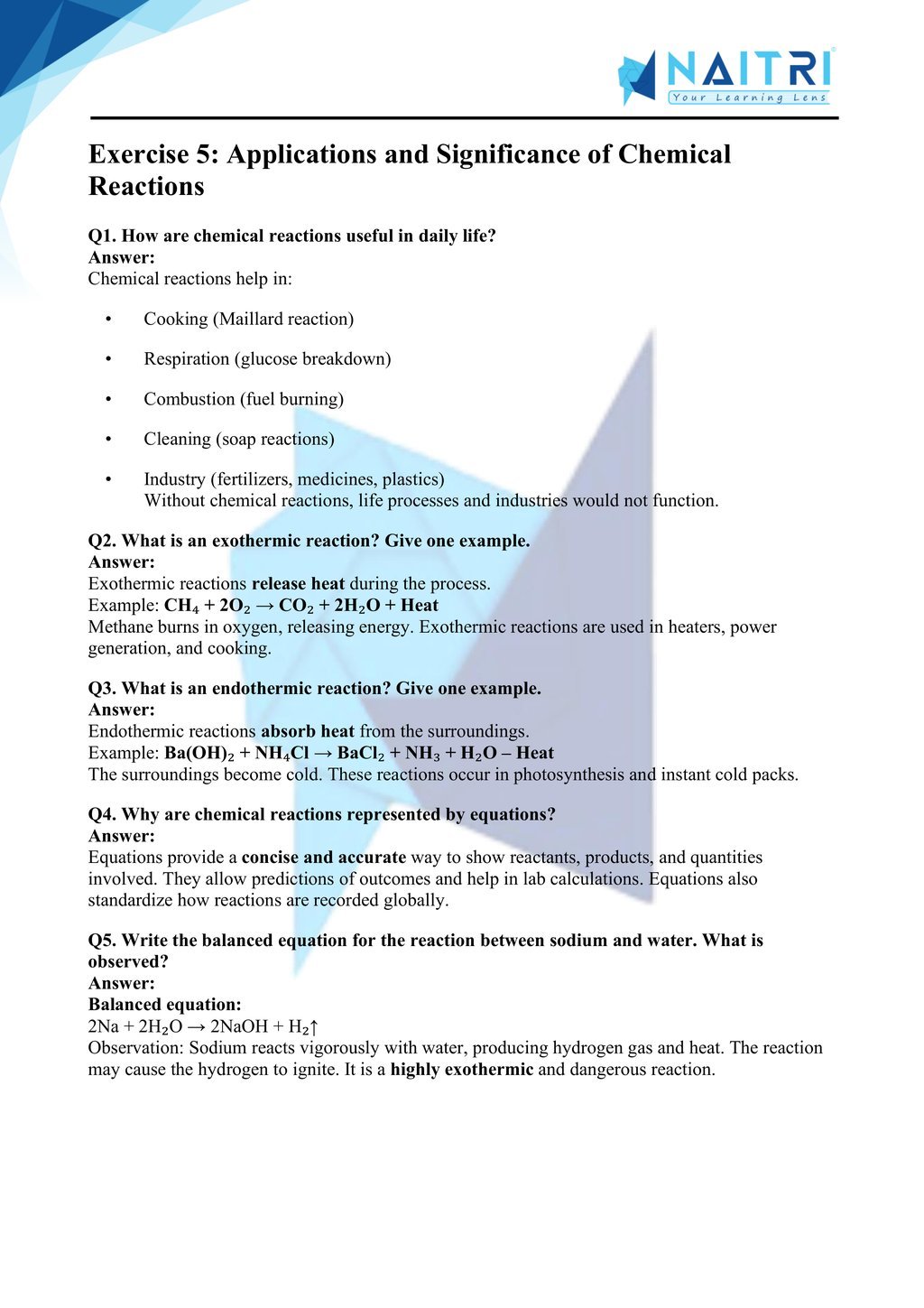
Experience Science Like Never Before – With AR!
Understanding Chemical Reactions and Equations is now more exciting and immersive! With the NAITRI App, you can explore complex science concepts through Augmented Reality (AR). Watch chemical reactions ignite, color changes occur, and equations balance visually — right in front of you. Our AR-powered lessons make learning interactive, 3D, and fun, helping you retain concepts better and enjoy every topic.



Visualize . Interact . Understand . The future of learning is here
Chemical Reactions and Equations – Important Questions with Answers
1. Define chemical reaction. Provide an example.
Answer: A chemical reaction involves breaking and forming bonds, resulting in new substances with different chemical properties. For example, combining hydrogen gas and oxygen gas produces water (2H₂ + O₂ → 2H₂O).
2. What are reactants and products in a chemical reaction?
Answer: Reactants are starting materials consumed during a reaction, while products are substances formed at the end. For instance, in combustion of methane, CH₄ and O₂ are reactants and CO₂ and H₂O are products.
3. Why is it necessary to balance chemical equations?
Answer: Balancing chemical equations ensures the law of conservation of mass is obeyed. It shows equal numbers of each element’s atoms on both sides, confirming mass is neither created nor destroyed.
4. Define a skeleton chemical equation.
Answer: A skeleton equation shows reactants and products with correct chemical formulas but without matching the number of atoms on each side, acting as the starting point for balancing chemical reactions.
5. Give an example of an exothermic reaction and explain briefly.
Answer: Combustion of methane (CH₄ + 2O₂ → CO₂ + 2H₂O) is exothermic. It releases significant heat and light energy due to bond formation, making it feel hot.
6. Give an example of an endothermic reaction and explain briefly.
Answer: The decomposition of calcium carbonate (CaCO₃ → CaO + CO₂) is endothermic because it absorbs heat from its environment to break down into calcium oxide and carbon dioxide gas.
7. Define oxidation and reduction with examples.
Answer: Oxidation involves loss of electrons or gain of oxygen, such as in 2Mg + O₂ → 2MgO. Reduction involves gain of electrons or loss of oxygen, for example CuO + H₂ → Cu + H₂O.
8. What is a redox reaction?
Answer: A redox reaction combines oxidation and reduction processes, where one species loses electrons (oxidized) and another gains electrons (reduced), such as Zn + CuSO₄ → ZnSO₄ + Cu.
9. Name an oxidizing agent and a reducing agent with examples.
Answer: A strong oxidizing agent is potassium permanganate (KMnO₄), which gains electrons. A reducing agent is hydrogen sulfide (H₂S), which donates electrons, for example, H₂S + Cl₂ → 2HCl + S.
10. What is a precipitation reaction? Provide an example.
Answer: A precipitation reaction forms an insoluble solid (precipitate) when two aqueous solutions react. For instance, mixing silver nitrate with sodium chloride forms white AgCl precipitate and aqueous NaNO₃.
11. Define and give an example of displacement reaction.
Answer: In a displacement reaction, a more reactive element replaces a less reactive one from its compound. For example, zinc metal displaces copper in copper sulfate solution to form zinc sulfate and copper metal.
12. What is a combination reaction? Give an example.
Answer: A combination reaction occurs when two or more reactants combine to form a single product. A classic example is the reaction of hydrogen and oxygen forming water (2H₂ + O₂ → 2H₂O).
13. What is decomposition reaction? Give an example.
Answer: A decomposition reaction involves a single compound breaking down into two or more simpler substances. For instance, heating potassium chlorate (2KClO₃) produces potassium chloride and oxygen gas.
14. Explain gas evolution reactions with an example.
Answer: Gas evolution reactions occur when a gas is produced as one of the products. For example, reacting hydrochloric acid with zinc metal evolves hydrogen gas (Zn + 2HCl → ZnCl₂ + H₂).
15. Define corrosion and describe its effect on metals.
Answer: Corrosion is the gradual destruction of metals through chemical reactions with environmental elements like oxygen and water, leading to undesirable compounds like rust in iron, which weakens structural integrity.
16. Describe the process of rusting of iron with a balanced equation.
Answer: Rusting involves iron reacting with oxygen and water to form hydrated iron(III) oxide. Balanced equation: 4Fe + 3O₂ + xH₂O → 2Fe₂O₃·xH₂O, producing the reddish-brown rust commonly seen on iron surfaces.
17. Provide two effective methods for preventing rusting of iron. Explain briefly.
Answer: Rusting can be prevented using protective coatings such as paint or oil and galvanization, which involves applying a zinc coat. Zinc acts as a sacrificial anode, corroding in place of iron.
18. Define rancidity with reference to food spoilage.
Answer: Rancidity refers to the oxidation of fats and oils in foods, resulting in unpleasant smells and flavors. This occurs when fatty acids react with oxygen, degrading nutritional value and making food inedible.
19. Suggest one practical method to prevent rancidity in cooking oils.
Answer: Storing oils in airtight, opaque containers and adding antioxidants like vitamin E helps reduce exposure to oxygen and light, effectively slowing down the rancidity process and increasing oil shelf life.
20. Define catalytic reactions and explain their significance with one example.
Answer: Catalytic reactions use a catalyst to speed up chemical transformations without being consumed. The iron catalyst in the Haber process enhances nitrogen conversion to ammonia at lower temperatures and higher efficiency.
21. Explain the role of catalyst in Haber’s process for ammonia production.
Answer: In Haber’s process, iron catalyst lowers activation energy, allowing nitrogen and hydrogen gases to react at relatively low temperatures and pressures, improving ammonia yield while maintaining energy efficiency.
22. Provide a balanced chemical equation for ammonia production in Haber’s process.
Answer: Nitrogen and hydrogen gas react in a 1:3 ratio over iron catalyst at high temperature and pressure to yield ammonia gas: N₂ + 3H₂ → 2NH₃.
23. Write a balanced equation for the rusting of iron.
Answer: The rusting process can be represented as 4Fe + 3O₂ + xH₂O → 2Fe₂O₃·xH₂O, where x indicates the number of water molecules involved; this forms hydrated iron(III) oxide.
24. Write the balanced chemical equation for glucose respiration in humans.
Answer: Photosynthesis and respiration formulas: C₆H₁₂O₆ + 6O₂ → 6CO₂ + 6H₂O + energy. This includes metabolic energy stored in ATP molecules.
25. Define a chemical equation and list its key components.
Answer: A chemical equation symbolically represents a reaction using formulas of reactants and products, separated by arrows, coefficients, and state symbols to follow conservation laws and indicate physical states.
Chemical Reactions and Equations introduces the transformation of substances through chemical changes. Students learn to write and balance chemical equations and understand different types of reactions such as combination, decomposition, displacement, and redox reactions. Real-life examples like rusting and digestion help link theory with practice. This chapter lays the foundation for advanced topics in Chemistry by building strong reasoning about how substances interact and change.
Related Chapters You May Like
Download Naitri App
Easy, Visual Learning — Right on Your Phone
Learn with Augmented Reality! The Naitri app makes CBSE and MP Board concepts interactive and fun — even in low-resource settings. Watch lessons, complete homework, take tests, and track progress — all in one place. Anytime. Anywhere.
Available on








